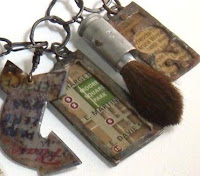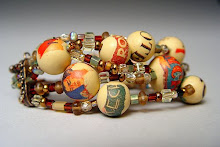
Two weeks ago I took a class with
Dan Cormier, a polymer clay artist and master craftsman. After the class was over, he walked down the hall into my studio and upon entering my workspace said, "your studio is a mess". As he looked beyond the mess to the work hanging on the wall he said, "I admire your ability to constrain chaos into such refined work."
This isn't the first time someone has commented on my messy space. Usually I respond by smiling and saying, "this is a working studio". Some of you may have been to my
Artspace Studio in Downtown Raleigh's City Market and know that I work in an open studio environment, which means my studio is open to the public five days a week. I sometimes compare the experience to being in a fish bowl, however, my process and my work space is the same as it would be if I were working in a home studio. In fact, my work space at Artspace is more contained than my home studio ever was, since I only have a little more than 200 square feet in which to work.
I will say that at this point I do not have a home studio. All of the components that go into my pieces are made at Artspace. When I am in production, that is getting ready for craft shows or exhibitions, I will bring the finished components home and string bracelets and necklaces at my kitchen table.
Long before I set up my studio at Artspace, I attended a workshop with polymer clay artist, friend, and mentor
Irene Semanchuk Dean. The workshop was how to sell and market your work and as part of the curriculum Irene talked about how to set up a studio. I did implement many of the principles Irene talked about in her workshop when I first set up my home studio, namely having a specific area set aside for each process. It wasn't hard because I was only working in one medium, polymer clay. I had an area for conditioning the clay, working with the raw clay, curing the clay, and sanding and finishing.
I tried to set up my studio at Artspace the same way. However, since I moved into Artspace four years ago, I have become an adventurer... diving into new mediums and exploring new dimensions in jewelry design. Now my one work table, which started out being used solely to condition and work with polymer clay, is now also used for painting, enameling, Precious Metal Clay, BronzClay, and porcelain. A couple of years ago, I did put in a jewelers bench, but I only use that for fabricating metal. My studio hasn't gotten bigger, just my ideas, which is part of my growth and development as a professional artist.

Notwithstanding the other forty or so studio artists in the Artspace building, most of whose workspaces I have seen, I went online to see if I could find pictures of other creative workspaces, and I realize that I am not alone in my chaos. While some artists have neat and organized workspaces, like my studio partner
Sharron Parker, many are like me. After viewing photos of other artist creative workspaces, one blogger wrote of his own workspace, "I am the kind of artist who brings order from chaos."
Workspaces aside, I think most artists have the ability to constrain chaos into art, which is fundamentally how I think our artist brains are programmed to work. We take all of information that is flinging towards us (at home, in the news, in the world) and filter it, interpret it, and ultimately translate it into a work of art.
I suppose a more organized studio would streamline the artistic process, however, I would submit to you that my ability to constrain chaos into art is an intregal part of my artistic process.
If you have a creative workspace that you would like to share, e-mail me a picture at
lauren@onlylauren.com and I will post it here.
To view other creative workspaces and home offices go to:
http://parkablogs.com/content/creative-workspaces-and-home-offices
 Earlier this year, Pantone, the world's authority on color, came out with its color forecast for Fall 2009.
Earlier this year, Pantone, the world's authority on color, came out with its color forecast for Fall 2009.








 According to its website, "Since its inception Artspace has inspired more than 2 million visitors and served as the heart of Raleigh’s visual art community. Artspace offers more than 100,000 visitors annually over 30 challenging and award-winning exhibitions, interactive workshops to over 2,000 school-aged children each year, art programming for at-risk youth, classes and workshops to over 3,000 youth and adults annually, and over 200 public events open to all in the community free of charge."
According to its website, "Since its inception Artspace has inspired more than 2 million visitors and served as the heart of Raleigh’s visual art community. Artspace offers more than 100,000 visitors annually over 30 challenging and award-winning exhibitions, interactive workshops to over 2,000 school-aged children each year, art programming for at-risk youth, classes and workshops to over 3,000 youth and adults annually, and over 200 public events open to all in the community free of charge."








 My only critique of The Bain Project is that it only lasted two weekends. We were there on the last day, along with hundreds of people and I felt like the word was just getting out. Apparently there are plans to renovate the building and turn it into shops and restaurants. For at least a weekend though we had a glimpse into the past.
My only critique of The Bain Project is that it only lasted two weekends. We were there on the last day, along with hundreds of people and I felt like the word was just getting out. Apparently there are plans to renovate the building and turn it into shops and restaurants. For at least a weekend though we had a glimpse into the past.






















